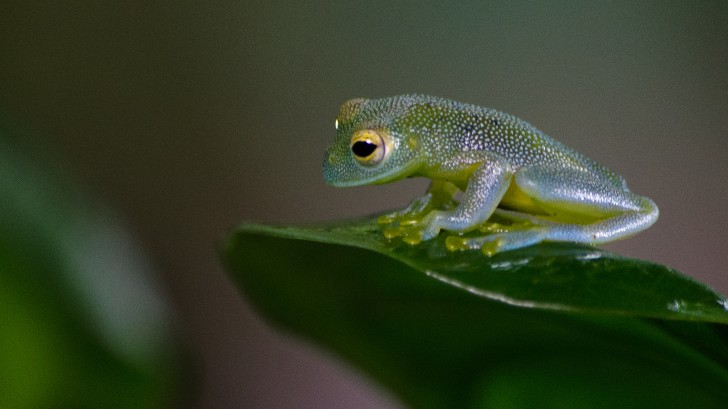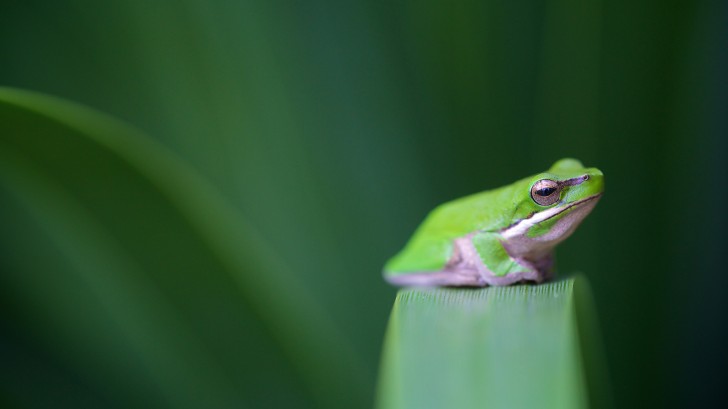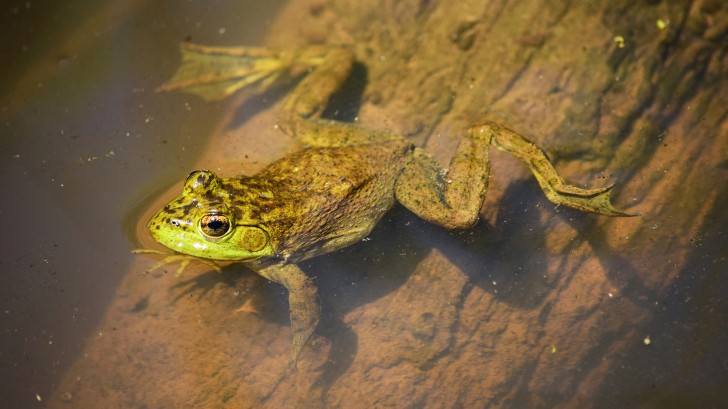“In the 1980s, people just didn’t think frogs were disappearing. Scientists said ‘don’t panic, we need the stats to prove it, all populations have natural fluctuations over time,’ and so on,” says Dr Lee Berger of James Cook University in Australia.
“By the time of the World Congress of Herpetology [the study of reptiles and amphibians] in 1990, researchers had to admit that the frogs had disappeared, they couldn’t find them and they didn’t understand why they had vanished or what to do.”
The crisis had started as early as the 1970s, when frogs began to quietly vanish from the rivers, marshes and forests of the world, taken down by a new and insidious menace: Batrachochytrium dendrobatidis, a pathogenic fungus that is lethal to frogs. Also known as “chytrid”, the fugus slowly suffocates the frog as it impairs the normal functioning of its skin. Animals can die within a week of infection. Entire populations seem to vanish overnight.
“It was shocking to watch the spread of the disease happen in real time 15 years ago,” says Jamie Voyles, assistant professor at the University of Nevada. “In Panama, spots in the rainforest were deafeningly loud with amphibian calls. Their abundance was incredible; you couldn’t even walk through the forest without worrying about stepping on them. The next summer they were just gone.”

Just as the disappearance of birdsong alerted scientists to the devastating impacts of pesticides on eggshells, the eerie quiet of the rainforest told biologists something was wrong.
The most famous casualty: the Costa Rican golden toad (Incilius periglenes), which has not been seen since 1989. Australia’s spectacularly quirky gastric-brooding frogs (Rheobatrachus), which gestated froglets in their stomachs, are also gone.
It’s hard to know for sure how many species chytrid has consigned to extinction, but a recent study estimates 200 species of frog have been wiped out by the fungus. Many now are just hanging on after being decimated by the disease, which as has affected 700 species worldwide.
“Older people say the Australian mountains used to be positively noisy with the calls of the Corroboree frog – they were so abundant people used them as fishing bait. Now there are less than 100 in the wild,” says Berger.
Today, the remaining frogs have been sequestered in a 30 sq m outdoor enclosure, protected by a 3m-high metal fence. “It’s not an ideal solution, but it has been a success,” she says.
Her diagnosis is not to be taken lightly. Berger has studied chytrid since the beginning; she is one of the co-discoverers of the fungus, which she tracked as part of her PhD thesis and described in the journal PNAS in 1998.
It is believed the international trade in the African clawed frog Xenopus laevis – widely used as pregnancy tests in the 1950s and ‘60s – released the fungus into the wild. As the African amphibians co-existed with the fungus in their native habitats they had some resistance to it. But other amphibians were not so lucky.
By the time Berger identified chytrid in 1998, it had spread to every continent but Antarctica.
Because amphibians’ skin is permeable, they are vulnerable to any environmental factor that interferes with their epidermal layers, such as pesticides, fertilizers, UV radiation and pharmaceuticals in wastewater. As amphibians spend part of their lives in water and part on land, they are doubly susceptible to any environmental threat. No wonder some biologists think of amphibians as “canaries in the coal mine”: they can signal wider environmental catastrophes as they begin to unfurl.
In the most recent official estimate, the Global Amphibian Assessment of 2004, 43 per cent of amphibians are listed as being in decline and 30 per cent are threatened to some degree (contrasting darkly with a quarter of mammals and about a tenth of birds). These “official” numbers are more than a decade out of date, and most herpetologists believe 50 per cent of amphibians are at risk of extinction within the next five years.
“Diseases don’t pay attention to park borders – many of these extinctions have taken place in beautiful, pristine forest reserves,” says Dr Simon Clulow of the University of Newcastle in Australia.
“It is important to recognise that chytrid is the most devastating wildlife disease ever to emerge, and it’s not going away anytime soon. I expect I will be working on how to combat this disease for the rest of my career.”
Clulow discovered one reason for optimism. In outdoor field experiments, he found raising the salinity of water by just 0.5 parts per trillion was enough to dramatically reduce infection rates and increase survival rates.
“It’s really just a slight increase in the salinity. You could drink a glass of this and not taste the salt,” says Clulow. The technique would not work for all environments, but in ponds or artificial habitats this simple trick would be an easy way for biologists to protect frogs while having negligible effects on the rest of the ecosystem.

In another study yet to be published in the journal Conservation Physiology, Clulow reports successfully producing embryos and one sexually mature adult from cryopreserved testicular tissue from male eastern dwarf tree frogs (Litoria fallax). This he says is a proof of concept that assisted reproductive technologies could be used in the future to bring threatened populations back from the brink.
“We need to be ready to rescue ‘insurance populations’ straight away from the wild and put them into captive breeding programs, and use modern tools to save them,” he says.
One major research focus should be identifying the genetic factors that make some frog species or individuals more resilient than others, says Berger.
“If we can find the genetic factors that make some frogs immune, we could look at using artificial selection or transgenesis to breed resistant strains of frogs and release them back into the wild,” she says.
On the bright side, biologists know a lot more about the disease now than they did in the 1980s, so for the few species of amphibian that are still unaffected, conservationists will be far better equipped to protect them.
One major priority: the island of Papua New Guinea is home to six per cent of the world’s frog species and is the largest land mass the fungus has not reached (apart from Antarctica).
“So far Papua New Guinea has just been lucky, but I think it’s only a matter of time, I think it’s a question of when, not if the fungus will arrive,” says Clulow.
Research suggests that some frogs naturally have symbiotic microbes on their skin which have evolved to fight off the fungus. “In Papua New Guinea we have been taking skin samples from frogs and performing transcriptomics to identify what’s living on their skin, and test out various hypotheses, so we can be ready to battle chytrid when it lands.”
Other biologists have been exploring the possibility of creating a vaccine of sorts by spraying animals with dead samples of the disease, inoculating them to fight off virulent, living pathogens.
Another reason for cautious optimism: wild populations appear to be evolving resistance to the fungus. This year, Voyles reported in the journal Science that some wild populations in Panama are bouncing back because they have naturally evolved greater resistance to the fungus.
In areas of Panama where the fungus had been present for many years, Voyles found clown frogs (Atelopus varius) were more capable of fighting off the infection. This would indicate a shift from the epidemic stage of the outbreak, to a more stabilised pandemic phase, where animals have naturally become more resistant and co-exist with the fungus. Though only 12 per cent of Panama’s frog species have returned to pre-outbreak levels, this does suggest amphibians around the world have the capacity to naturally recover and stabilise.
“It’s only a small subset of all the species that declined, so it’s not a simple end to the problem, but it does give me a glimmer of hope,” says Voyles. “We still want to send out a call to arms to mobilise the world to tackle this, because there are other chytrid fungi out there that could still pose a threat.”
In May, an international team of scientists reported in the journal Science that they had tracked down where Batrachochytrium dendrobatidis originally came from: Korea, in the mid-twentieth century.
We can use this knowledge to prevent other outbreaks of a similar nature. Korea is home to many more fungal species that could also spread globally. Already a related fungus, Batrachochytrium salamandrivorans, is wiping out salamanders worldwide. Scientists only reported the discovery of this pathogen in 2013, so it is early days yet in the outbreak.

“There will be more amphibian extinctions as long as our population keeps growing and the resources we direct towards conservation don’t keep pace,” says Kerry Kriger of Save The Frogs. “We can’t do anything about that for now – but what we can do is stop the international trade in amphibians, which was the biggest driver behind the spread of chytrid in the first place. As long as we ship 100 million amphibians a year for the pet trade and for food, amphibian diseases will continue to spread with them. The state of California for example has known for a decade that imported bull frogs are infected with chytrid, but the government has done nothing to stop the importations.”
Professor Karen Lips of the University of Maryland, who has been studying the chytrid outbreak for 20 years, agrees that the biggest precautionary step we could take would be to limit the international trade in amphibians as pets and food.
“We need new laws that require testing and quarantine of animals that are imported. Right now people can easily buy a pet frog that hasn’t been certified as clean, and if they just bury it in the backyard when it dies, that can be a new source of infection,” she says. “Based on what they saw in Korea just now, we know there will be more amphibian chytrid diseases out there.”
In addition to the new salamander fungus, bats in North America have been affected by a strange new fungal disease known as “white nose syndrome,” and the continent’s snakes are being wiped out by a new fungal disease called Ophidiomyces ophiodiicola, only identified by scientists in 2015.
“Chytrid is the worst wildlife disease we have ever seen, so the least we can do is take lessons from this and apply them to other new and emerging pathogens,” says Prof Lips. “And with changing human migration patterns and climate change, we are bound to see more.”
Prof Berger agrees that chytrid should act as a call to arms to bring in new regulations and dedicate resources to stopping emerging diseases before they cause global catastrophe.
“The lack of a global effort and dedicated funding has been very frustrating,” says Berger. “It’s important to remember that the reason a lot of species haven’t gone extinct is because of the dedication of a few individuals who really have just handed their lives over to stop these animals from going extinct. Without their commitment things would be so much worse.”